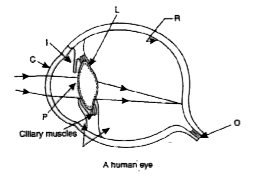Answer the following questions.
What gives a perception of depth or three dimensional vision to human eye?
To answer the question "What gives a perception of depth or three-dimensional vision to the human eye?", we can break down the explanation into a few key steps:
1. Understanding Binocular Vision:
- Humans have two eyes positioned slightly apart from each other. This is known as binocular vision.
2. Different Angles of View:
- Each eye views an object from a slightly different angle due to the separation between them. This means that each eye captures a unique image of the same object.
3. Brain Processing:
- The brain receives the two images from the eyes and processes them simultaneously. It combines these images to create a single three-dimensional perception.
4. Depth Perception:
- The slight differences in the images allow the brain to interpret depth. It can determine how far away an object is based on the disparity between the two images.
5. Practical Demonstration:
- A simple experiment to illustrate this is to close one eye and try to touch the tips of two pins held in each hand. This task becomes challenging because the depth perception is compromised. However, when both eyes are open, the task becomes much easier due to the enhanced depth perception.
Conclusion:
The perception of depth or three-dimensional vision in humans is primarily due to having two eyes that provide different angles of view, which the brain processes to create a sense of depth.
---
- Humans have two eyes positioned slightly apart from each other. This is known as binocular vision.
- Each eye views an object from a slightly different angle due to the separation between them. This means that each eye captures a unique image of the same object.
- The brain receives the two images from the eyes and processes them simultaneously. It combines these images to create a single three-dimensional perception.
- The slight differences in the images allow the brain to interpret depth. It can determine how far away an object is based on the disparity between the two images.
- A simple experiment to illustrate this is to close one eye and try to touch the tips of two pins held in each hand. This task becomes challenging because the depth perception is compromised. However, when both eyes are open, the task becomes much easier due to the enhanced depth perception.
The perception of depth or three-dimensional vision in humans is primarily due to having two eyes that provide different angles of view, which the brain processes to create a sense of depth.
Similar Questions
Knowledge Check
The range of vision of human eye is
Ainfinite to 25mB1cm to 25cmC100m to 25cmDinfinite to 25cmThe persistence of vision for human eye is
A1/10th of a secondB1/16th of a secondC1/6th of a secondD1/18th of a secondWhat is the function of iris in human eye?
ATo control or regulate the amount of coming light to the eyeBTo return the coming light to the eyeCto send the photo to the image lensDNone of the above
Answer the following questions.
What is the far point of a normal human eye?
View SolutionGive an example of three-dimensional motion.
View SolutionAnswer the following questions.
How does the defect of myopia arise in a human eye?
View SolutionAnswer the following questions briefly :
What do you understand by human poverty?
View SolutionLook at the figure and answer the following questions:

What is the name of the circular aperture through which light enters the eye?
View Solution
